

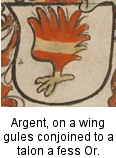

One of the most common mistakes people make when blazoning their armory is to confuse the various terms using the names of ordinaries, like "a fess", "per fess", "in fess" and "fesswise". While these terms may sound similar, their meanings are completely different, and replacing one with another can make your blazon misleading or even nonsensical.
The most obvious of these constructions are phrases in the form "a(n) [ordinary]". They simply indicate that an ordinary of the mentioned type is, itself, on the field or charge. The lines along its edges may be plain or complex; in the latter case, a term describing the type of line follows the phrase, as in "a pale engrailed" or "a fess nebuly".




Phrases in the form "per [ordinary]" describe tinctures. They may apply to fields or to variegated charges. A field per pale azure and argent, for instance, is divided into two parts, one blue and one white, along a line that runs down it where a pale would. A lion per fess Or and gules, similarly, is half gold and half red, divided along a line that runs across it just as a fess would. Again, the line itself might be plain or complex; in the latter case, a term describing the type of line follows the phrase, as in "per pale indented" or "per fess wavy".
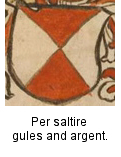
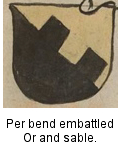

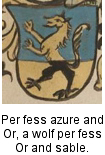
Phrases of the form "in [ordinary]" describe arrangements of charges. Generally, they indicate that if you drew a line or lines through all the charges you'd create a shape like the ordinary in question. Three mullets in pale, for instance, would be arranged so that a line through all three would be vertical, like a pale, while if three mullets in fess were connected the line would be horizontal, like a fess. Where crosses and saltires are concerned, the phrase might also indicate that the charges overlap one another in such a way that they form the ordinary's shape. Two ladders in cross, for instance, would consist of one vertical and one horizontal ladder that overlapped in the middle. It should be easy to tell which applies in any given instance, based on the number of charges involved.
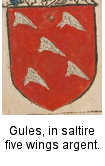
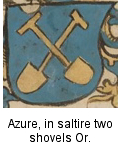


These terms are usually not used if the charges are in a default or forced arrangement. Four pheons on a pale, for instance, would almost certainly be in pale, since any other arrangement would require them to be drawn far too small for identifiability. For similar reasons, three crescents in chief above a fess would probably be in fess.
Terms of the form "[ordinary]wise" describe orientation. They indicate that a line drawn down the long axis of a charge would be at the same angle as the ordinary in question. A sword palewise, for instance, has its tip toward the top and its grip toward the bottom of the device, so a line down the length of it would be vertical, like a pale. A spear fesswise, on the other hand, has its point toward the dexter and its base toward the sinister side of the shield. A line down its length would be horizontal, like a fess. When the terms are applied to winged animals, they normally describe a line drawn from the animal's head to its other end, even if the wings are displayed and the distance from wingtip to wingtip is greater.
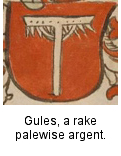
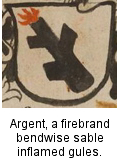


These terms don't apply to charges that don't have long axes, like roses or mullets of six points which are essentially round. They also don't apply to animals that are in default orientations for their postures. A lion rampant is largely vertical, for instance, but it's not necessary to call it "palewise" since that is part of what "rampant" means. By the same token, a horse passant is largely horizontal; you don't need "fesswise" to tell you that.
It is possible to use two or more ordinary-based terms to describe a single piece of armory, or even a single charge or charge group. Each term has its own, distinct job to do, and they have no effect on one another.
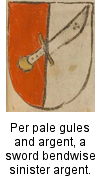
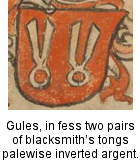
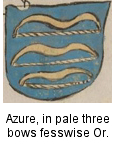
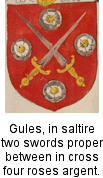
Most of the images in this article come from either BSB Cod.icon. 309, which was painted in southern Germany between 1475 and 1560, or BSB Cod.icon. 291, which was painted in England in the middle of the 16th century. Both are in the collection of the Bavarian State Library. "Gules, in pall three fish Or," and "Gules, an eagle displayed fesswise argent," are from Johann Siebmacher's armorial, painted in Germany in 1605.
 Coblaith Muimnech holds
the copyright to this document, including all illustrations not
excerpted from works more than 300 years old. It is made available
under a Creative Commons Attribution-Noncommercial-Share
Alike 3.0 United States License.
Coblaith Muimnech holds
the copyright to this document, including all illustrations not
excerpted from works more than 300 years old. It is made available
under a Creative Commons Attribution-Noncommercial-Share
Alike 3.0 United States License.